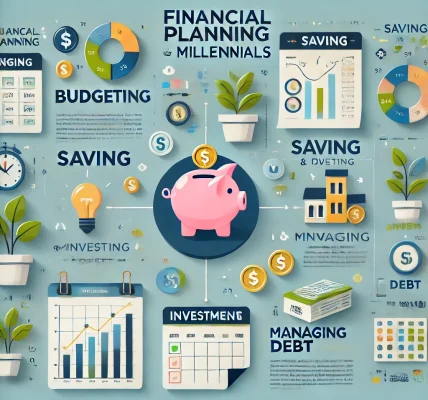Introduction
Setting financial goals is an essential step toward financial security and independence. As we enter 2025, creating a clear financial roadmap can help you manage money efficiently, eliminate debt, save for the future, and build wealth. However, unrealistic goals can lead to frustration and setbacks. The key is to set achievable, well-defined financial targets that align with your income, expenses, and long-term aspirations.
This guide will walk you through the step-by-step process of setting and achieving financial goals effectively in 2025.
Step 1: Assess Your Current Financial Situation
Before setting goals, take an honest look at your current financial standing. This includes:
- Income: Calculate your total earnings, including salary, investments, and side hustles.
- Expenses: Track monthly spending using budgeting apps or spreadsheets.
- Debt: List all outstanding loans, including credit card debt, student loans, and mortgages.
- Savings and Investments: Review emergency funds, retirement accounts, and investment portfolios.
- Credit Score: Check your credit report for accuracy and improvement areas.
A clear understanding of your financial health will help set practical and attainable goals.
Step 2: Define Your Financial Goals Using the SMART Framework
SMART (Specific, Measurable, Achievable, Relevant, Time-bound) goals provide clarity and motivation.
- Specific: Clearly define what you want to achieve (e.g., “Save $10,000 for a house down payment”).
- Measurable: Track progress using a financial planner or app.
- Achievable: Set realistic targets based on your financial capacity.
- Relevant: Align goals with your life priorities (e.g., debt repayment, homeownership, retirement planning).
- Time-bound: Assign deadlines to each goal (e.g., “Save $5,000 by June 2025”).
Step 3: Categorize Your Goals
Break your financial goals into short-term, mid-term, and long-term objectives:
Short-Term Goals (0-2 Years)
- Build an emergency fund covering 3-6 months of expenses.
- Pay off high-interest credit card debt.
- Create and stick to a monthly budget.
- Increase monthly savings by 10%.
Mid-Term Goals (2-5 Years)
- Save for a down payment on a home.
- Pay off student loans or car loans.
- Start investing in stocks, mutual funds, or real estate.
Long-Term Goals (5+ Years)
- Achieve financial independence.
- Build a retirement fund with contributions to a 401(k), IRA, or pension plan.
- Save for children’s education.
- Establish passive income streams.
Step 4: Develop a Budget and Stick to It
A budget helps you allocate income efficiently to meet financial goals.
Popular Budgeting Methods:
- 50/30/20 Rule: 50% for essentials (housing, food, bills), 30% for discretionary spending (entertainment, shopping), and 20% for savings and debt repayment.
- Zero-Based Budgeting: Assign every dollar of income a purpose to avoid unnecessary expenses.
- Envelope System: Use cash envelopes for different spending categories to control expenses.
Use budgeting tools like Mint, YNAB (You Need a Budget), or Personal Capital for effective financial tracking.
Step 5: Build an Emergency Fund
Unexpected expenses can derail financial plans. An emergency fund acts as a financial safety net.
How Much to Save?
- Start with at least 3 months’ worth of expenses.
- Ideally, aim for 6-12 months for greater financial security.
- Keep funds in a high-yield savings account for easy access and growth.
Step 6: Reduce and Eliminate Debt
Debt can hinder financial growth. Prioritize debt repayment using these strategies:
- Avalanche Method: Pay off high-interest debt first (e.g., credit cards) while making minimum payments on others.
- Snowball Method: Pay off the smallest debt first for psychological motivation, then move to larger ones.
- Debt Consolidation: Combine multiple debts into a single loan with lower interest rates.
- Negotiate Lower Interest Rates: Contact lenders for better repayment terms.
Step 7: Increase Your Income
Boosting income accelerates goal achievement. Consider:
- Negotiating a raise at your current job.
- Starting a side hustle (freelancing, online business, consulting).
- Investing in dividend-paying stocks or real estate.
- Monetizing skills through online courses or tutoring.
Step 8: Invest for Long-Term Growth
Investing is crucial for wealth-building and financial independence.
Best Investment Options for 2025:
- Stock Market: Invest in ETFs, index funds, or dividend stocks.
- Retirement Accounts: Maximize 401(k), Roth IRA, or Traditional IRA contributions.
- Real Estate: Rental properties provide passive income.
- Cryptocurrency and Alternative Assets: Diversify with caution and research.
Step 9: Monitor and Adjust Your Goals
Financial planning is dynamic. Regularly review and adjust goals based on life changes.
How to Stay on Track?
- Review goals every 3-6 months and adjust based on progress.
- Automate savings and investments to ensure consistency.
- Track net worth to measure financial growth.
- Seek professional advice if needed for investment and tax planning.
Conclusion
Setting and achieving realistic financial goals in 2025 requires careful planning, discipline, and continuous monitoring. By following structured steps—assessing finances, budgeting, saving, investing, and eliminating debt—you can secure your financial future with confidence.
Start today and take control of your financial journey!



